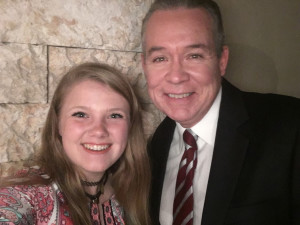Why a Japanese Steakhouse Proves That We Will Solve Our Climate Change Crisis
You likely know the type of place that I had dinner at last night. It’s a local Japanese Steakhouse called Samurai. It happens to be the first place my parents went to on their first actual date together (for lunch, over 30 years ago) and is the type of restaurant where you sit at a large cooktop table and the Chef comes out and cooks your food right in front of you. There always seems to be some shrimp being served in addition to steak and chicken and somewhere along the way the Chef will flip a shrimp tail up into the air and have it land in his tall Chef’s hat as part of the entertainment. Anyway, I am sure you know the type of place I am talking about.
Last night I went there with about a dozen of my friends from High School including my best friend, Amanda, who was home for a few days from college visiting her family. The place was packed because, well it was Friday night and honestly it’s always packed and that brings me to why a Japanese steakhouse should give us all hope that my generation will solve climate change.
You see, during our 30 or so minute wait for our table, while we were chatting and getting caught up about school, the holidays and one thing or another I saw a young girl waving towards our group from the other side of the restaurant. At first I assumed she was waving at someone else but after a few seconds, and a few more waves from her in my direction, I realized that she was both waving at me and that I recognized her from a lecture I’d given a few weeks ago at her school here in Coconut Grove, The Carrollton School of the Sacred Heart.
Realizing who she was I walked over to her to say hello and as I approached I noticed that she was actually part of a much larger group and learned that the 15 or so girls were all classmates and at dinner together to celebrate a birthday. As soon as they all realized that I was the girl who had lectured at their school recently about climate change I was surrounded by excited children wanting to talk about my visit and sea level rise.
The important part of this story has nothing to do with food but is that these girls, each of them a Middle Schooler, were entirely enthusiastic about talking about, heck solving, climate change and sea level rise. They are girls who are excited about science in a world where science is too often dominated by boys. And they are girls who are already doing something to solve the problem and who even at a young age are confident that they will solve the problem.
One of the girls explained that following my lecture she’s frequently been talking to her parents about why they should install solar power in their home. Another eagerly shared with me that she’d gotten a science kit for her birthday and was happy to find that it had included a solar car project (Note to parents; girls love science as much as boys so science kits, Maker project kits and microscopes make excellent gifts for girls as much as they do for boys!). Each of these young ladies were articulate, engaged and ever so positive that they and their friends will help me solve our global climate crisis.
The reaction that I saw from them last night gave me great hope, and should give you hope too, that it’s only a matter of time before my generation, these girls included, grow up and fix what’s broken.
Now, my dinner plans aside, allow me to share that not only is the Carrollton School of the Sacred Heart a beautiful campus on the shores of Biscayne Bay but it is also a green one full of bright young girls that are passionate about STEAM (Science, Technology, Engineering, Architecture and Math) topics. Between solar arrays, a bike share program, and curriculum designed to teach them all about climate change and sea level rise through interactive experiments, the girls of Carrollton are very well aware of what is happening to our planet. They even have their own Maker Space and in it have the distinction of being the only school in Miami-Dade to have constructed a solar powered race car. And can I say again that this is an all-girls school. How cool is that! Go girls!
Last month I had the privilege of lecturing to nearly 200 of Carrollton’s students and while there I got to meet many of the girls and learned about their fabulous campus. Thanks Ms. Thome for the invitation. These young ladies were knowledgeable about the challenges our climate and region face as well as possible solutions. It was clear they’d studied the topic and were eager to learn more but their studies aside, what I saw and heard last night proved that the lessons they’d learned in class have touched their hearts and are inspiring their minds.
Allow me to end by thanking Ms. Thome, Mr. Cassell, and Headmaster Kalkus for having me on campus and speaking to your wonderful students. Thanks also to Isabella Hassun for introducing me before my lecture and, yes, waving at me across the room last night before dinner. Isabella, you might not know this yet, but you and your girlfriends are about to change the world and solve the greatest challenge our generation faces and before you do that you are giving hope to every adult that reads this blog and learns about you and your school.
Dear Delaney,
Thank you so much for your wonderful presentation to our students at Carrollton. You made such a strong connection with them and empowered them to take action. They will not forget you and your inspiring example.
Yesterday in my classes, I felt that you were right beside me. I referenced your explanation of the importance of mangroves as a first line of defense against storm surge and sea level rise as we looked at the front page of the Miami Herald from Sunday. And, as we examined our rainfall data collected on campus from the last month, your talk was mentioned as we talked about flooding episodes away from the coast and not related to rainfall. Thank you for bringing the chunk of Miami oolitic limestone for them to handle. As we looked at the population distribution within Miami Dade county, your explanation of the limestone ridge came right back to them!
I am so inspired by all the ways you communicate so clearly and effectively. Thank you for your outstanding work. You are welcome here anytime. Do not be surprised if a few of the girls reach out for advice. You have made an impact.
Thank you again!
Warmly,
Kate Thome
So, Ms. Thome, Mr. Cassell, Headmaster Kalkus and especially Isabella and your classmates, keep doing what you are doing because our environment needs all of the help it can get. And along the way, watch out for those flying shrimp the next time you are out to dinner!



